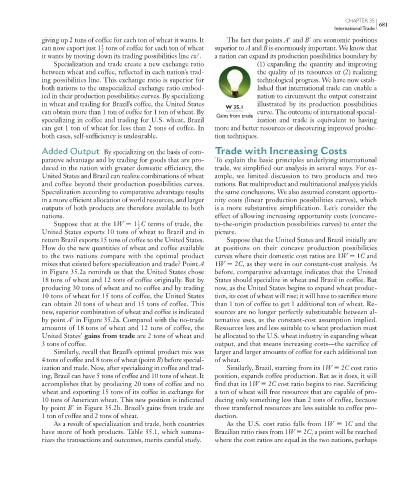Page 772 - Economics
P. 772
CONFIRMING PAGES
CHAPTER 35
681
International Trade
giving up 2 tons of coffee for each ton of wheat it wants. It The fact that points A and B are economic positions
1 _
can now export just 1 tons of coffee for each ton of wheat superior to A and B is enormously important. We know that
2
it wants by moving down its trading possibilities line cw . a nation can expand its production possibilities boundary by
Specialization and trade create a new exchange ratio (1) expanding the quantity and improving
between wheat and coffee, reflected in each nation’s trad- the quality of its resources or (2) realizing
ing possibilities line. This exchange ratio is superior for technological progress. We have now estab-
both nations to the unspecialized exchange ratio embod- lished that international trade can enable a
ied in their production possibilities curves. By specializing nation to circumvent the output constraint
in wheat and trading for Brazil’s coffee, the United States W 35.1 illustrated by its production possibilities
can obtain more than 1 ton of coffee for 1 ton of wheat. By Gains from trade curve. The outcome of international special-
specializing in coffee and trading for U.S. wheat, Brazil ization and trade is equivalent to having
can get 1 ton of wheat for less than 2 tons of coffee. In more and better resources or discovering improved produc-
both cases, self-sufficiency is undesirable. tion techniques.
Added Output By specializing on the basis of com- Trade with Increasing Costs
parative advantage and by trading for goods that are pro- To explain the basic principles underlying international
duced in the nation with greater domestic efficiency, the trade, we simplified our analysis in several ways. For ex-
United States and Brazil can realize combinations of wheat ample, we limited discussion to two products and two
and coffee beyond their production possibilities curves. nations. But multiproduct and multinational analysis yields
Specialization according to comparative advantage results the same conclusions. We also assumed constant opportu-
in a more efficient allocation of world resources, and larger nity costs (linear production possibilities curves), which
outputs of both products are therefore available to both is a more substantive simplification. Let’s consider the
nations. effect of allowing increasing opportunity costs (concave-
1 _
Suppose that at the 1 W 1 C terms of trade, the to-the-origin production possibilities curves) to enter the
2
United States exports 10 tons of wheat to Brazil and in picture.
return Brazil exports 15 tons of coffee to the United States. Suppose that the United States and Brazil initially are
How do the new quantities of wheat and coffee available at positions on their concave production possibilities
to the two nations compare with the optimal product curves where their domestic cost ratios are 1 W 1 C and
mixes that existed before specialization and trade? Point A 1 W 2 C , as they were in our constant-cost analysis. As
in Figure 35.2a reminds us that the United States chose before, comparative advantage indicates that the United
18 tons of wheat and 12 tons of coffee originally. But by States should specialize in wheat and Brazil in coffee. But
producing 30 tons of wheat and no coffee and by trading now, as the United States begins to expand wheat produc-
10 tons of wheat for 15 tons of coffee, the United States tion, its cost of wheat will rise; it will have to sacrifice more
can obtain 20 tons of wheat and 15 tons of coffee. This than 1 ton of coffee to get 1 additional ton of wheat. Re-
new, superior combination of wheat and coffee is indicated sources are no longer perfectly substitutable between al-
by point A in Figure 35.2a . Compared with the no-trade ternative uses, as the constant-cost assumption implied.
amounts of 18 tons of wheat and 12 tons of coffee, the Resources less and less suitable to wheat production must
United States’ gains from trade are 2 tons of wheat and be allocated to the U.S. wheat industry in expanding wheat
3 tons of coffee. output, and that means increasing costs—the sacrifice of
Similarly, recall that Brazil’s optimal product mix was larger and larger amounts of coffee for each additional ton
4 tons of coffee and 8 tons of wheat (point B ) before special- of wheat.
ization and trade. Now, after specializing in coffee and trad- Similarly, Brazil, starting from its 1 W 2 C cost ratio
ing, Brazil can have 5 tons of coffee and 10 tons of wheat. It position, expands coffee production. But as it does, it will
accomplishes that by producing 20 tons of coffee and no find that its 1 W 2 C cost ratio begins to rise. Sacrificing
wheat and exporting 15 tons of its coffee in exchange for a ton of wheat will free resources that are capable of pro-
10 tons of American wheat. This new position is indicated ducing only something less than 2 tons of coffee, because
by point B in Figure 35.2b . Brazil’s gains from trade are those transferred resources are less suitable to coffee pro-
1 ton of coffee and 2 tons of wheat. duction.
As a result of specialization and trade, both countries As the U.S. cost ratio falls from 1 W 1 C and the
have more of both products. Table 35.1 , which summa- Brazilian ratio rises from 1 W 2 C , a point will be reached
rizes the transactions and outcomes, merits careful study. where the cost ratios are equal in the two nations, perhaps
mcc26632_ch35_674-695.indd 681 9/14/06 4:32:08 PM
9/14/06 4:32:08 PM
mcc26632_ch35_674-695.indd 681

